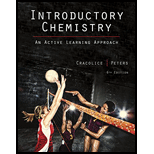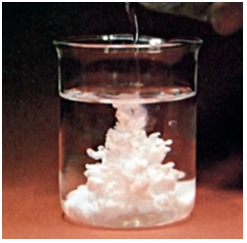
Introductory Chemistry: An Active Learning Approach
6th Edition
ISBN: 9781305632608
Author: CRACOLICE, Mark S., PETERS, Ed
Publisher: Brooks Cole
expand_more
expand_more
format_list_bulleted
Concept explainers
Textbook Question
Chapter 16, Problem 148E
An analytical procedure for finding the chloride ion concentration in a solution involves the precipitation of silver chloride: Ag++Cl−→AgCl. What is the molarity of the chloride ion if 16.80 mL of 0.629 M silver nitrate (the source of silver ion) is needed to precipitate all of the chloride ion in a 25.00-mL sample of the unknown?

Silver nitrate solution is added to an unknown chloride-ion solution, yielding a precipitate of silver chloride.
Expert Solution & Answer
Trending nowThis is a popular solution!

Students have asked these similar questions
What is the total energy cost associated with the compound below adopting the shown conformation?
CH3
HH
DH
CH3
ΗΝ,
Draw Final Product
C
cyclohexanone
pH 4-5
Edit Enamine
H3O+
CH3CH2Br
THF, reflux
H
Edit Iminium Ion
How many hydrogen atoms are connected to the indicated carbon atom?
Chapter 16 Solutions
Introductory Chemistry: An Active Learning Approach
Ch. 16 - Mixtures of gases are always true solutions. True...Ch. 16 - Every pure substance has a definite and fixed set...Ch. 16 - Can you see particles in a solution? If yes, give...Ch. 16 - What kinds of solute particles are present in a...Ch. 16 - Distinguish between the solute and solvent in each...Ch. 16 - Explain why the distinction between solute and...Ch. 16 - Prob. 7ECh. 16 - Prob. 8ECh. 16 - What happens if you add a very small amount of...Ch. 16 - Prob. 10E
Ch. 16 - Prob. 11ECh. 16 - Prob. 12ECh. 16 - Prob. 13ECh. 16 - Prob. 14ECh. 16 - Prob. 15ECh. 16 - What does it mean to say that a solute particle is...Ch. 16 - Prob. 17ECh. 16 - Prob. 18ECh. 16 - Describe the changes that occur between the time...Ch. 16 - Prob. 20ECh. 16 - Prob. 21ECh. 16 - Prob. 22ECh. 16 - Prob. 23ECh. 16 - Prob. 24ECh. 16 - Prob. 25ECh. 16 - Prob. 26ECh. 16 - Prob. 27ECh. 16 - Which of the following solutes do you expect to be...Ch. 16 - Prob. 29ECh. 16 - Prob. 30ECh. 16 - Prob. 31ECh. 16 - Prob. 32ECh. 16 - Prob. 33ECh. 16 - Prob. 34ECh. 16 - Prob. 35ECh. 16 - Prob. 36ECh. 16 - Prob. 37ECh. 16 - A student weighs out a 4.80-g sample of aluminum...Ch. 16 - Prob. 39ECh. 16 - Prob. 40ECh. 16 - Prob. 41ECh. 16 - Prob. 42ECh. 16 - Potassium hydroxide is used in making liquid soap....Ch. 16 - You need to make an aqueous solution of 0.123M...Ch. 16 - What volume of concentrated sulfuric acid, which...Ch. 16 - Prob. 46ECh. 16 - Prob. 47ECh. 16 - Prob. 48ECh. 16 - Prob. 49ECh. 16 - Prob. 50ECh. 16 - Despite its intense purple color, potassium...Ch. 16 - Prob. 52ECh. 16 - 53. The density of 3.30M potassium nitrate is...Ch. 16 - Prob. 54ECh. 16 - Prob. 55ECh. 16 - Prob. 56ECh. 16 - Prob. 57ECh. 16 - Prob. 58ECh. 16 - Prob. 59ECh. 16 - Prob. 60ECh. 16 - Prob. 61ECh. 16 - Prob. 62ECh. 16 - Prob. 63ECh. 16 - Prob. 64ECh. 16 - Prob. 65ECh. 16 - Prob. 66ECh. 16 - Prob. 67ECh. 16 - Prob. 68ECh. 16 - What are the equivalent mass of Cu(OH)2 and...Ch. 16 - Prob. 70ECh. 16 - Prob. 71ECh. 16 - Prob. 72ECh. 16 - Prob. 73ECh. 16 - Prob. 74ECh. 16 - Prob. 75ECh. 16 - Prob. 76ECh. 16 - Prob. 77ECh. 16 - Prob. 78ECh. 16 - Prob. 79ECh. 16 - Prob. 80ECh. 16 - Prob. 81ECh. 16 - Prob. 82ECh. 16 - What is the molarity of the acetic acid solution...Ch. 16 - Prob. 84ECh. 16 - Prob. 85ECh. 16 - Prob. 86ECh. 16 - Prob. 87ECh. 16 - Prob. 88ECh. 16 - Prob. 89ECh. 16 - Prob. 90ECh. 16 - Prob. 91ECh. 16 - Prob. 92ECh. 16 - Calculate the mass of calcium phosphate that will...Ch. 16 - How many milliliters of 0.464M nitric acid...Ch. 16 - Prob. 95ECh. 16 - Prob. 96ECh. 16 - What volume of 0.842M sodium hydroxide solution...Ch. 16 - Prob. 98ECh. 16 - The equation for a reaction by which a solution of...Ch. 16 - Potassium hydrogen phthalate is a solid,...Ch. 16 - Prob. 101ECh. 16 - Oxalic acid dihydrate is a solid, diprotic acid...Ch. 16 - A student finds that 37.80mL of a 0.4052MNaHCO3...Ch. 16 - Prob. 104ECh. 16 - Prob. 105ECh. 16 - Prob. 106ECh. 16 - Prob. 107ECh. 16 - Prob. 108ECh. 16 - Prob. 109ECh. 16 - Prob. 110ECh. 16 - Prob. 111ECh. 16 - Prob. 112ECh. 16 - Prob. 113ECh. 16 - Prob. 114ECh. 16 - Prob. 115ECh. 16 - Prob. 116ECh. 16 - Prob. 117ECh. 16 - The specific gravity of a solution of KCl is...Ch. 16 - A student dissolves 27.2g of aniline, C6H5NH2, in...Ch. 16 - Prob. 120ECh. 16 - Prob. 121ECh. 16 - Prob. 122ECh. 16 - Prob. 123ECh. 16 - Prob. 124ECh. 16 - Prob. 125ECh. 16 - Prob. 126ECh. 16 - When 12.4g of an unknown solute is dissolved in...Ch. 16 - Prob. 128ECh. 16 - Prob. 129ECh. 16 - When 19.77g of glucose, C6H12O6(180.2g/mol), is...Ch. 16 - Prob. 131ECh. 16 - Prob. 132ECh. 16 - When you heat water on a stove, small bubbles...Ch. 16 - Antifreeze is put into the water in an automobile...Ch. 16 - Prob. 135ECh. 16 - Prob. 136ECh. 16 - Prob. 137ECh. 16 - Prob. 138ECh. 16 - Prob. 139ECh. 16 - Prob. 140ECh. 16 - The density of 18.0%HCl is 1.09g/mL. Calculate its...Ch. 16 - Prob. 142ECh. 16 - Prob. 143ECh. 16 - Prob. 144ECh. 16 - Prob. 145ECh. 16 - A student adds 25.0mL of 0.350M sodium hydroxide...Ch. 16 - Prob. 147ECh. 16 - An analytical procedure for finding the chloride...Ch. 16 - Prob. 149ECh. 16 - Prob. 150ECh. 16 - Prob. 151ECh. 16 - A chemist combines 60.0mL of 0.322M potassium...Ch. 16 - A solution is defined as a homogeneous mixture. Is...Ch. 16 - Prob. 154ECh. 16 - Prob. 16.1TCCh. 16 - 0.100gof A is dissolved in 1.00 103mL of water,...Ch. 16 - Prob. 16.3TCCh. 16 - If you are given the structural formulas of two...Ch. 16 - Prob. 1CLECh. 16 - Prob. 2CLECh. 16 - Write a brief description of the relationships...Ch. 16 - Prob. 4CLECh. 16 - Prob. 5CLECh. 16 - Write a brief description of the relationships...Ch. 16 - Prob. 1PECh. 16 - What mass of sodium chloride and what volume of...Ch. 16 - Prob. 3PECh. 16 - Prob. 4PECh. 16 - Prob. 5PECh. 16 - Prob. 6PECh. 16 - Prob. 7PECh. 16 - Determine the number of equivalents of acid and...Ch. 16 - Prob. 9PECh. 16 - Prob. 10PECh. 16 - Prob. 11PECh. 16 - Prob. 12PECh. 16 - Prob. 13PECh. 16 - Prob. 14PECh. 16 - Prob. 15PECh. 16 - Prob. 16PECh. 16 - What volume of 0.105M lithium nitrate must be...Ch. 16 - Prob. 18PECh. 16 - Prob. 19PECh. 16 - Prob. 20PECh. 16 - Prob. 21PECh. 16 - Prob. 22PECh. 16 - The freezing point of cyclohexane is 6.50C, and...
Knowledge Booster
Learn more about
Need a deep-dive on the concept behind this application? Look no further. Learn more about this topic, chemistry and related others by exploring similar questions and additional content below.Similar questions
- Identify the compound with the longest carbon - nitrogen bond. O CH3CH2CH=NH O CH3CH2NH2 CH3CH2C=N CH3CH=NCH 3 The length of all the carbon-nitrogen bonds are the samearrow_forwardIdentify any polar covalent bonds in epichlorohydrin with S+ and 8- symbols in the appropriate locations. Choose the correct answer below. Η H's+ 6Η Η Η Η Η Ηδ Η Ο Ο HH +Η Η +Η Η Η -8+ CIarrow_forwardH H:O::::H H H HH H::O:D:D:H HH HH H:O:D:D:H .. HH H:O:D:D:H H H Select the correct Lewis dot structure for the following compound: CH3CH2OHarrow_forward
- Rank the following compounds in order of decreasing boiling point. ннннн -С-С-Н . н-с- ННННН H ΗΤΗ НННН TTTĪ н-с-с-с-с-о-н НННН НН C' Н н-с-с-с-с-н НН || Ш НННН H-C-C-C-C-N-H ННННН IVarrow_forwardRank the following compounds in order of decreasing dipole moment. |>||>||| ||>|||>| |>|||>|| |||>||>| O ||>>||| H F H F H c=c || H c=c F F IIIarrow_forwardchoose the description that best describes the geometry for the following charged species ch3-arrow_forward
- Why isn't the ketone in this compound converted to an acetal or hemiacetal by the alcohol and acid?arrow_forwardWhat is the approximate bond angle around the nitrogen atom? HNH H Harrow_forwardOH 1. NaOCH2CH3 Q 2. CH3CH2Br (1 equiv) H3O+ Select to Draw 1. NaOCH2 CH3 2. CH3Br (1 equiv) heat Select to Edit Select to Drawarrow_forward
- Complete and balance the following half-reaction in acidic solution. Be sure to include the proper phases for all species within the reaction. S₂O₃²⁻(aq) → S₄O₆²⁻(aq)arrow_forwardQ Select to Edit NH3 (CH3)2CHCI (1 equiv) AICI 3 Select to Draw cat. H2SO4 SO3 (1 equiv) HO SOCl2 pyridine Select to Edit >arrow_forwardComplete and balance the following half-reaction in basic solution. Be sure to include the proper phases for all species within the reaction. Zn(s) → Zn(OH)₄²⁻(aq)arrow_forward
arrow_back_ios
SEE MORE QUESTIONS
arrow_forward_ios
Recommended textbooks for you
 ChemistryChemistryISBN:9781305957404Author:Steven S. Zumdahl, Susan A. Zumdahl, Donald J. DeCostePublisher:Cengage Learning
ChemistryChemistryISBN:9781305957404Author:Steven S. Zumdahl, Susan A. Zumdahl, Donald J. DeCostePublisher:Cengage Learning Chemistry: An Atoms First ApproachChemistryISBN:9781305079243Author:Steven S. Zumdahl, Susan A. ZumdahlPublisher:Cengage Learning
Chemistry: An Atoms First ApproachChemistryISBN:9781305079243Author:Steven S. Zumdahl, Susan A. ZumdahlPublisher:Cengage Learning
 Chemistry: Principles and ReactionsChemistryISBN:9781305079373Author:William L. Masterton, Cecile N. HurleyPublisher:Cengage Learning
Chemistry: Principles and ReactionsChemistryISBN:9781305079373Author:William L. Masterton, Cecile N. HurleyPublisher:Cengage Learning Chemistry: The Molecular ScienceChemistryISBN:9781285199047Author:John W. Moore, Conrad L. StanitskiPublisher:Cengage Learning
Chemistry: The Molecular ScienceChemistryISBN:9781285199047Author:John W. Moore, Conrad L. StanitskiPublisher:Cengage Learning Chemistry: Principles and PracticeChemistryISBN:9780534420123Author:Daniel L. Reger, Scott R. Goode, David W. Ball, Edward MercerPublisher:Cengage Learning
Chemistry: Principles and PracticeChemistryISBN:9780534420123Author:Daniel L. Reger, Scott R. Goode, David W. Ball, Edward MercerPublisher:Cengage Learning

Chemistry
Chemistry
ISBN:9781305957404
Author:Steven S. Zumdahl, Susan A. Zumdahl, Donald J. DeCoste
Publisher:Cengage Learning

Chemistry: An Atoms First Approach
Chemistry
ISBN:9781305079243
Author:Steven S. Zumdahl, Susan A. Zumdahl
Publisher:Cengage Learning


Chemistry: Principles and Reactions
Chemistry
ISBN:9781305079373
Author:William L. Masterton, Cecile N. Hurley
Publisher:Cengage Learning

Chemistry: The Molecular Science
Chemistry
ISBN:9781285199047
Author:John W. Moore, Conrad L. Stanitski
Publisher:Cengage Learning

Chemistry: Principles and Practice
Chemistry
ISBN:9780534420123
Author:Daniel L. Reger, Scott R. Goode, David W. Ball, Edward Mercer
Publisher:Cengage Learning
Precipitation Reactions: Crash Course Chemistry #9; Author: Crash Course;https://www.youtube.com/watch?v=IIu16dy3ThI;License: Standard YouTube License, CC-BY